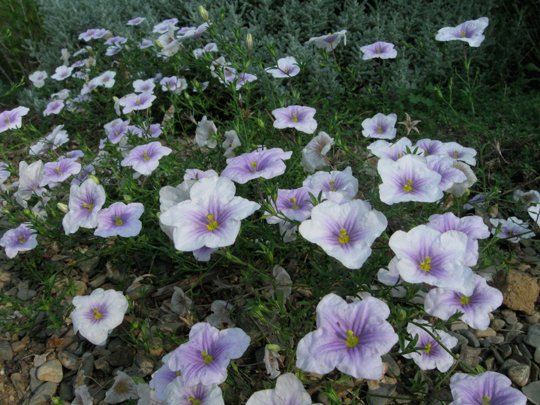It’s spring time, and looking out across the nursery I can see frothy waves of fresh green, spiced with yellow, orange and red flowers. Apparently Robin Williams once said “Spring is nature’s way of saying “Let’s Party!”.” As the new leaves popping out from their dark parent branches gently assault my eyeballs, I totally get what Robin Williams was saying. Walking through the greenhouses here, it’s easy to get sort of blasé about all the flowers: sure, that’s a nice yellow; okay, that’s a pretty vibrant red, mmm hmm. And then there’s something like Bicolor Sage. It has a pow all its own, but in a good way. And it’s something of a relief after all the fireworks of the reds and yellows, and even pure whites. Here are some of the best blues for your garden to soothe your senses, maybe while listening to some John Lee Hooker.
Oops! Wait, wait, wait. I told myself I wasn’t going to do that. I wasn’t going to do some kind of cheesy “blue flowers/blues music” type of thing. So here they are, with no distractions: the straight-forward blues.
 |
| Bicolor Sage |
Bicolor Sage is a low-growing sage with electric blue flowers set against dark bronze foliage. Either full sun or part shade will keep this salvia blooming throughout the warm season.
The blue blooms of Bicolor Sage are vivid and cool even when no longer on the plant.
Plumbago is a low, mounding shrub with light, clear blue flowers.
 |
| Plumbago auriculata |
Here in Austin it usually stays between one foot and three feet tall. I’ve heard stories about Plumbago becoming large, six-foot shrubs in San Antonio.
 |
| Salvia transylvanica |
This salvia gets up to 30 inches tall and 18 inches wide. It produces light blue flowers as soon as it warms up in the spring, and it will re-bloom if cut back after the first flush.
Salvia farinacea is one of those workhorses of the garden. It just keeps going and going. It needs at least part sun to bloom, but once it does start to bloom, it’s spectacular. ‘Mealy Blue Sage’ is fairly drought-tolerant.
Nierembergia gracilis is another low growing perennial that blooms all summer. It’s drought tolerant to the point of being easily over-watered.
 |
| Shrubby Purple Skullcap |
Scutellaria wrightii only gets 10 to 12 inches tall by 18 inches wide. It pretty well covers itself in purple-blue blooms all spring and summer, which stand out against the light grey foliage. Very drought tolerant, this plant is a good candidate for a xeriscape bed. Or even a zeroscape bed.
 |
| Po' Lightnin' |
Ha.









